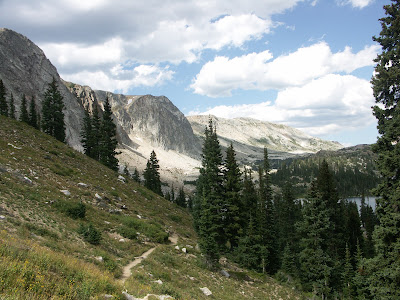Brown-capped Rosy-Finch Survey in the Snowy Range Important Bird Area
July 20, 2013
Please join us for a day of hiking and bird surveying in the beautiful Snowy Mountains! We will be conducting the Laramie Audubon Society’s annual Brown-capped Rosy-Finch survey in the Snowy Range on July 20, 2013this year.
 |
| Brown-capped Rosy-Finch in Snowy Mountain IBA |
In 2003, Audubon Wyoming designated a site within the Snowy Range as one of Wyoming’s Important Birds Areas because its alpine habitat supports Wyoming’s only breeding population of the Brown-capped Rosy-Finch. This bird is a species of concern because it breeds only in the Snowies and on mountain peaks in Colorado and northern New Mexico. If the current global warming trend continues, its mountain habitat islands are likely to shrink and to be invaded by other avian species that are currently excluded by the harsh conditions. Documenting how many Brown-capped Rosy-Finches are in the area and where they are feeding and nesting can help us to monitor this population and determine how the birds are faring.
This year, the Wyoming Natural Diversity Database has teamed up with Laramie Audubon to develop additional survey routes so we can get a more accurate picture of where rosy-finches occur and are nesting in the Snowies. We also will be attempting to make our data collection slightly more rigorous by using GPS units to mark our observation points and our nest locations. If you have a GPS and are willing to use it, please bring it along on the survey.
Please let Sophie know if you will be joining us on the survey and if you plan to bring your own GPS unit at 307-742-6138 or at sophie_osborn@hotmail.com.
We will meet on July 20, 2013 at 8:30am at the Forest Service Visitor Center, on WY 130, approximately 1-2 miles west of Centennial WY. After a brief orientation session, we will divide the group into teams and will divide up the survey routes.
This year, the Wyoming Natural Diversity Database has teamed up with Laramie Audubon to develop additional survey routes so we can get a more accurate picture of where rosy-finches occur and are nesting in the Snowies. We also will be attempting to make our data collection slightly more rigorous by using GPS units to mark our observation points and our nest locations. If you have a GPS and are willing to use it, please bring it along on the survey.
Please let Sophie know if you will be joining us on the survey and if you plan to bring your own GPS unit at 307-742-6138 or at sophie_osborn@hotmail.com.
We will meet on July 20, 2013 at 8:30am at the Forest Service Visitor Center, on WY 130, approximately 1-2 miles west of Centennial WY. After a brief orientation session, we will divide the group into teams and will divide up the survey routes.
 |
| Medicine Bow Peak area in the Snowy Mountain IBA |
What to expect: Be prepared to spend the day hiking and looking for rosy-finches. The birds are not in predictable locations so considerable walking may be required. Some of the trails have fairly steep portions and the elevation can be challenging for some people. You may also spend time sitting in certain areas to search for or observe birds. Most survey routes are along established trails; a few of the new routes will be off-trail.
What to look for: In spring and summer, Brown-capped Rosy-Finches often feed at the edge of snowdrifts, where seeds that were blown onto the snowpack during winter emerge from the melting snow cover. Spring winds also blow insects from lower elevations that settle onto the snow where they can be found by birds that are gathering food for their nestlings. Nests are well hidden in talus and in shallow crevices in rock faces. When seen feeding on bright snow, rosy-finches may appear to be a solid dark color. In better light, their light-pink flanks and rumps are visible and they show a flash of pink in their wings when in flight.
What to look for: In spring and summer, Brown-capped Rosy-Finches often feed at the edge of snowdrifts, where seeds that were blown onto the snowpack during winter emerge from the melting snow cover. Spring winds also blow insects from lower elevations that settle onto the snow where they can be found by birds that are gathering food for their nestlings. Nests are well hidden in talus and in shallow crevices in rock faces. When seen feeding on bright snow, rosy-finches may appear to be a solid dark color. In better light, their light-pink flanks and rumps are visible and they show a flash of pink in their wings when in flight.
 |
| Brown-capped Rosy-Finch in Snowy Range IBA |
What to bring: Binoculars and/or spotting scope, a field guide, warm clothes (including wind protection), lunch and snacks, water, and sunblock. Please bring a GPS unit if you have one. We will provide route maps.
Note: all photos in this post are © Shawn Billerman
Note: all photos in this post are © Shawn Billerman

No comments:
Post a Comment